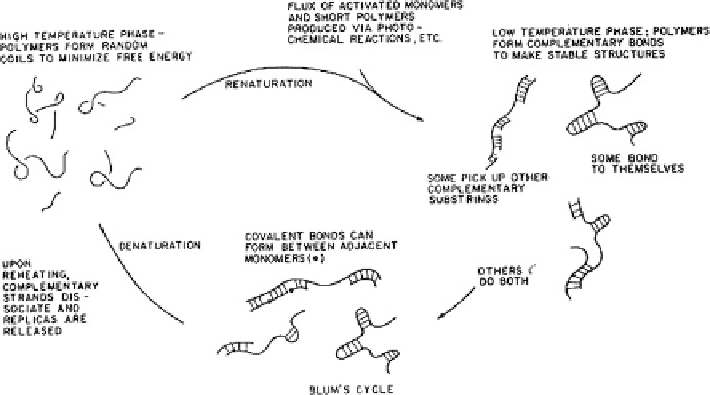Biology Reference
In-Depth Information
Fig. 13.1 The proposed model of the origin of biological information (and life) based on the
concept of
frustrations
(Anderson 1983, 1987). Due to the presence of
frustrations
, some polymer
chains cannot self-conjugate, thereby exposing single-stranded segments to environment to act as
templates for self-replication (Reproduced from Anderson 1983, 1987)
least one pair of components whose spins are parallel to each other and hence of a
non-minimal energy. Anderson and his colleagues represented the nucleotide
sequence of an RNA molecule as a string of binary digits or spins, designating G
as + +, C as
, A as +
, and U as
+ (which obeys the Watson--Crick pairing
rule). This allowed them to calculate the free energy (i.e., spin glass Hamiltonian, a
mathematical function mapping spin configuration to the total energy of the spin
system) of RNA molecules described as linear strings of spins. Furthermore, they
defined what is referred to as the “death function”
D(S)
as a nonlinearly decreasing
function of the
spin glass Hamiltonian
:
DðSÞ¼
1
f
exp[
HðSÞþr
Nþ
1
g
(13.1)
=
where
H(S)
is the spin glass Hamiltonian (or the total energy of the spin system S),
r
is proportionality constant and
N
is the number of spins in the system (which is less
than ten in the case studied in Fig.
13.2
below). Repeated applications of Eq.
13.1
to
a collection of short RNA sequences showed that certain sequences died out with
time (see the 7- and 8-mers in Fig.
13.2
) whereas certain others (see the 11- and
12-mers) grew with repeated “thermal cycling,” reminiscent of the selective growth
of some nucleotide sequences in living systems. A similar finding was reported by
Zeldovich et al. (2007a, b, 2008) (see Sect.
14.7
).

